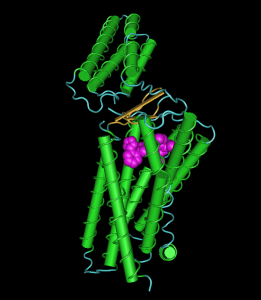Magnetism is helping animals to find their destinations, it does not matter whether they are very large like whales, small like pigeon, or very tiny like butterflies or bees, they are all dependent on the Earth magnitic field. The underlying mechanism how a magnetic field is recognized in biological terms is almost not understood.
It has been found already that the cryptochromes (Cry) have a role in magnetic reception since Cry-negative Drosophila loose their sensitivity to magnetic fields (see , , & Cryptochrome mediates light-dependent magnetosensitivity in Drosophila. Nature 454, 1014–1018 (2008)). Crytochromes are part of the intrinsic circadian clock, which resides in the human brain in the Suprachiasmatic Nucleus of the hypothalamus.
A group from Bejing has now presented a debated paper in Nature Materials that claims to have discovered a protein structure that is able to measure the magnetic field. The group around Can Xie has found that the Drosophila protein CG8198 forms complexes with FAD and Cry that establish a biomagnet. This is an astonishing piece of work. It is much debated, for example, for quantitative reasons: magnets have many more iron molecules to be seen orientating according to the field around. These tiny magnets which are in single cells, intracellular not intercellular, do not seem to have the effect necessary to communicate a message about the orientation. Whether this or the contrary will be confirmed by independent experiments, you can only guess. One could guess that cell cooperation will help to make the output from single cells large enough to become relevant. Nature there is a News & Yiews article about this paper, which is also worth reading.
This is very exciting and should be followed-up. Highly recommended!
